Traditionalist Issues
 |
 |
 |
 |
 |
 |
 |
Dialogue Mass - XCVII
No Valid Objections against the Loreto Tradition
At the beginning of the 20th century, which marked the high point of the Modernist movement in the Church, the Loreto tradition was challenged as never before, particularly by Catholic priests intent on disproving the miraculous translation of the Holy House.
The ‘Lapponi thesis’
This particular anti-Loreto legend started its life as a piece of ephemeral gossip, which has not yet been – and most likely never will be – substantiated by demonstrable evidence. In order to support the idea of a non-miraculous transportation of the Holy House, Fr. Santarelli recounted a curious tale first told by Msgr. Maurice Landrieux (later Bishop of Dijon) at the beginning of the 20th century. (1)
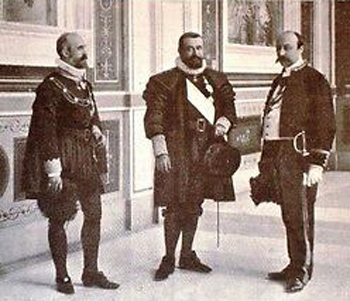 In Msgr. Landrieux’s Diary, there is an entry for May 17, 1900, recording a conversation he had with Pope Leo XIII’s personal physician, Giuseppe Lapponi, concerning the translation of the Holy House. According to this account, Lapponi told Landrieux that he had seen some documents in the Vatican Archives indicating that the Angeli family, a branch of the imperial family of Constantinople, had the Holy House transported from Nazareth to Loreto in order to save it from destruction by the Turkish invaders.
In Msgr. Landrieux’s Diary, there is an entry for May 17, 1900, recording a conversation he had with Pope Leo XIII’s personal physician, Giuseppe Lapponi, concerning the translation of the Holy House. According to this account, Lapponi told Landrieux that he had seen some documents in the Vatican Archives indicating that the Angeli family, a branch of the imperial family of Constantinople, had the Holy House transported from Nazareth to Loreto in order to save it from destruction by the Turkish invaders.
No details are given about the nature of the documents, their provenance or their location, and no one can access them because they have disappeared. If this information had first appeared on social media today, it would be an example of “fake news,” i.e., a narrative that cannot be verified, eludes investigation, encourages speculation and is relayed third hand by someone with an agenda.
Msgr. Landrieux had already a parti pris [bias; literally: party taken] in the matter: He had taken his stance against a miraculous explanation of the translation of the Holy House to Loreto. (2)
The Loreto tradition comes under neo-modernist control
Whatever attempts were made in the early 20th century to strip the Loreto tradition of its supernatural element, they remained within limited circulation, and they could not exert a negative effect on public perception of its miraculous nature.
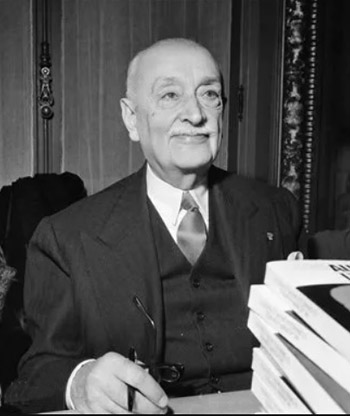 The first person to bring Lapponi’s anecdote to public notice was Wladimir d’Ormesson, the French Ambassador to the Holy See in the 1940s and '50s; he published Msgr. Landrieux’ diary note in 1959. (3) His personal Journal(4) gives some clues to his motivation.
The first person to bring Lapponi’s anecdote to public notice was Wladimir d’Ormesson, the French Ambassador to the Holy See in the 1940s and '50s; he published Msgr. Landrieux’ diary note in 1959. (3) His personal Journal(4) gives some clues to his motivation.
As one of the influential figures of progressivist Catholic circles in France and Italy, d’Ormesson was a friend and defender of Jacques Maritain, an enthusiastic supporter of Fr. Augustin Bea’s ecumenical initiatives, (5) and an admirer of Msgr. Giovanni Battista Montini. (6) He was also, crucially, a sworn enemy of traditionalist Catholics whom he called “intégristes,” and once asked Montini, as Pius XII’s “Substitute,” to take action against them in France. Leaving his diplomatic credentials behind, he went so far as to call them “sots” (fools). (7)
Following d’Ormesson’s example, Fr. Santarelli published the same narrative in 2016. (8) Both authors were acting in their official capacity – d’ Ormesson as Administrator of the National Chaplaincy of France in Loreto, (9) and Fr. Santarelli as Director of the Universal Congregation of the Holy House, which was established in 1883 to promote the Church’s teaching on the Santa Casa. (10)
But in spite of the unbroken tradition of the organizations they headed, neither of them was prepared to promote the tradition upheld over the centuries by previous incumbents of their posts. In the hands of such progressivists, the 700-year-old tradition was bound to be overturned and many of the faithful induced to despise what their forebears readily believed. Indeed, today, the invariable message from the bien-pensants of the Loreto institutions is that the non-miraculous translation of the Holy House has been “proved,” and the case closed.
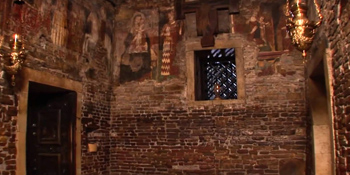
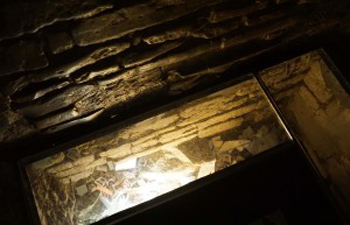 But nothing could be further from the truth, as the following counter-evidence shows.
But nothing could be further from the truth, as the following counter-evidence shows.
It has been alleged that in 1905 the French Oratorian Fr. Henri Thédenat confided to Professor Larquat, a former professor at the Catholic Institute of Paris, that he had found in the Vatican Archives a record of the cost of transporting the Holy House on board a ship from Nazareth to Loreto chartered by the Angeli family. Some of the stones, it was claimed, were numbered to ensure faithful rebuilding.
Again, as with the “Lapponi thesis,” we are given no details of date or authenticity of the document. The danger here is over-extrapolating the evidence. If we have good reasons to doubt that these assumptions hold true, then extrapolation is not a valid inferential procedure.
Too many questions are left unanswered. The Angeli family had no historical connection with the House in Nazareth; a contingent of stones could have been later transported from Nazareth to build the missing fourth wall; the partial numbering of the stones could have had a different origin and purpose. Everything is left to the imagination to fill in the details, and some recent authors have exploited the opportunity to the full with their fanciful reconstructions of the Loreto tradition. (16)
Buried coins
Two undated coins inscribed with the words Gui Dux Atenes (Guy II de La Roche, who was Duke of Athens from 1287 to 1308) were found in the subsoil of the Holy House during the 1962-1965 excavations. [Part 95] As it was an ancient custom for a builder to plant a coin in a new foundation (much like a modern “time capsule”), and as Guy was Thamar’s cousin and a member of the Angeli family, some saw this as proof that he had rebuilt the House in Loreto.
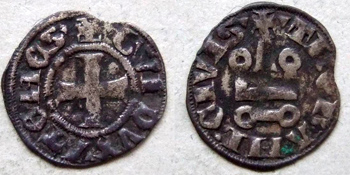 Is this true? No reasons are given to think so. Anyone in possession of such coins could have put them under the house at any time, and not all coins are buried under buildings for the same reasons.
Is this true? No reasons are given to think so. Anyone in possession of such coins could have put them under the house at any time, and not all coins are buried under buildings for the same reasons.
Historical evidence shows that concealed coins were part of pilgrimage vows. And this is certainly true of the Loreto Shrine where the excavations also unearthed a variety of coins placed by pilgrims from the early 14th century onwards, often en route to the Grotto of St. Michael the Archangel in Gargano, and from there to the Holy Land.
The Loreto tradition stands intact
The main problem with the official argument is not so much that its logic is flawed, or that there is no weighing and sifting of evidence, or attempt to reach conclusions that are justified by a process of deduction: it actually manipulates the reader into reaching misleading a priori conclusions.
We are presented with statements based on hypothetical guesswork that might (or might not) be supported by empirical evidence. And we are encouraged to believe that whatever it was that certain interested parties are alleged to have seen in the Archives constitutes damning evidence against the tradition of angelic intervention. But without knowing the precise nature of the evidence, no one can make an informed judgment on it.
What we can say with certainty is that no credible historic link has been established between the Angeli family and the arrival of the Holy House in Loreto.
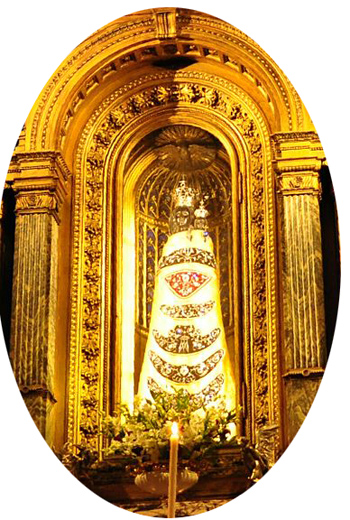 Continued
Continued

The ‘Lapponi thesis’
This particular anti-Loreto legend started its life as a piece of ephemeral gossip, which has not yet been – and most likely never will be – substantiated by demonstrable evidence. In order to support the idea of a non-miraculous transportation of the Holy House, Fr. Santarelli recounted a curious tale first told by Msgr. Maurice Landrieux (later Bishop of Dijon) at the beginning of the 20th century. (1)

Dr. Lapponi, physician to Leo XIII, first at right, was against the miraculous Translation
No details are given about the nature of the documents, their provenance or their location, and no one can access them because they have disappeared. If this information had first appeared on social media today, it would be an example of “fake news,” i.e., a narrative that cannot be verified, eludes investigation, encourages speculation and is relayed third hand by someone with an agenda.
Msgr. Landrieux had already a parti pris [bias; literally: party taken] in the matter: He had taken his stance against a miraculous explanation of the translation of the Holy House to Loreto. (2)
The Loreto tradition comes under neo-modernist control
Whatever attempts were made in the early 20th century to strip the Loreto tradition of its supernatural element, they remained within limited circulation, and they could not exert a negative effect on public perception of its miraculous nature.

Ambassador Wladimir d’Ormesson, a sworn enemy of traditionalist Catholics
As one of the influential figures of progressivist Catholic circles in France and Italy, d’Ormesson was a friend and defender of Jacques Maritain, an enthusiastic supporter of Fr. Augustin Bea’s ecumenical initiatives, (5) and an admirer of Msgr. Giovanni Battista Montini. (6) He was also, crucially, a sworn enemy of traditionalist Catholics whom he called “intégristes,” and once asked Montini, as Pius XII’s “Substitute,” to take action against them in France. Leaving his diplomatic credentials behind, he went so far as to call them “sots” (fools). (7)
Following d’Ormesson’s example, Fr. Santarelli published the same narrative in 2016. (8) Both authors were acting in their official capacity – d’ Ormesson as Administrator of the National Chaplaincy of France in Loreto, (9) and Fr. Santarelli as Director of the Universal Congregation of the Holy House, which was established in 1883 to promote the Church’s teaching on the Santa Casa. (10)
But in spite of the unbroken tradition of the organizations they headed, neither of them was prepared to promote the tradition upheld over the centuries by previous incumbents of their posts. In the hands of such progressivists, the 700-year-old tradition was bound to be overturned and many of the faithful induced to despise what their forebears readily believed. Indeed, today, the invariable message from the bien-pensants of the Loreto institutions is that the non-miraculous translation of the Holy House has been “proved,” and the case closed.

Above, the interior of the Holy House; below, in Loreto there is no foundation for the House

- According to the Chartularium Culisanense (item 2 of Folio 181), Nicephorous of Epirus gave the stones of the Holy House of Nazareth to his daughter, Thamar, as a dowry on her marriage to Prince Philip of Taranto in 1294. But the Holy House did not belong to Nicephorus, a Greek Schismatic, to give away. It was part of the Church of the Annunciation, which at that time was administered by a few Franciscans, although the area was in Muslim hands. (11)
- No mention is made in Folio 181 of the quantity of stones removed, whether a few precious “souvenirs,” as some pilgrims to Nazareth are known to have taken home, or many tons of rubble from the alleged demolition. There was no need to demolish the House, as it was underground, in the crypt of the church that was built over it, and could have easily been sealed off from hostile intrusion.
- It has never been satisfactorily explained how an entire edifice could have been transported from Nazareth in May 1291 and, as the Chartularium claims, shipped through the port of Acre to Epirus, which was then under siege. In April 1291 Al-Ashraf Khalil had arrived with his army, estimated by the chroniclers of the time at 200,000 men, and pitched his tent in front of the walls of the city. Acre was completely encircled, and the Muslim machines of war were installed. It stretches credulity to imagine how hundreds of cartloads of stones could have travelled through a war zone and slipped through the enemy lines unnoticed.
- The Crusaders could not have transported the stones because they were still defending the besieged city of Acre. The Holy House made its appearance in Dalmatia on the 10th of May before the departure of the military contingents of the Crusaders.
- Item 3 of the dowry simply mentions a painted panel of a Madonna and Child, and the unwarranted conclusion was made that this belonged to the Holy House.
- If the 52 items listed in Folio 181 represented the complete dowry of Thamar – which it is generally taken to be – then it is clearly an unauthentic document. The original dowry inventory itself seems not to have survived, (12) but studies in Byzantine history have identified some of its contents from other sources. From these we gather that some items are not mentioned in Folio 181, e.g., the “gold enameled locket decorated with the fleur-de-lys of the House of Anjou and the double-headed eagle of Byzantium.” (13)
- As Thamar’s marriage was an alliance of political expediency, (14) her dowry included an annuity, land and fortresses. (15) Yet there is no reference to these important assets in the Folio, or to any property in Palestine owned by Nicephorus.
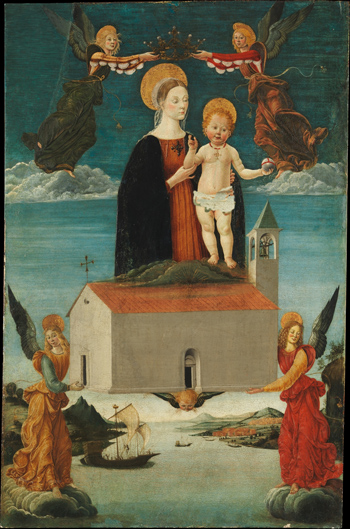
The Translation of the Holy House by Angels,
a solid tradition
It has been alleged that in 1905 the French Oratorian Fr. Henri Thédenat confided to Professor Larquat, a former professor at the Catholic Institute of Paris, that he had found in the Vatican Archives a record of the cost of transporting the Holy House on board a ship from Nazareth to Loreto chartered by the Angeli family. Some of the stones, it was claimed, were numbered to ensure faithful rebuilding.
Again, as with the “Lapponi thesis,” we are given no details of date or authenticity of the document. The danger here is over-extrapolating the evidence. If we have good reasons to doubt that these assumptions hold true, then extrapolation is not a valid inferential procedure.
Too many questions are left unanswered. The Angeli family had no historical connection with the House in Nazareth; a contingent of stones could have been later transported from Nazareth to build the missing fourth wall; the partial numbering of the stones could have had a different origin and purpose. Everything is left to the imagination to fill in the details, and some recent authors have exploited the opportunity to the full with their fanciful reconstructions of the Loreto tradition. (16)
Buried coins
Two undated coins inscribed with the words Gui Dux Atenes (Guy II de La Roche, who was Duke of Athens from 1287 to 1308) were found in the subsoil of the Holy House during the 1962-1965 excavations. [Part 95] As it was an ancient custom for a builder to plant a coin in a new foundation (much like a modern “time capsule”), and as Guy was Thamar’s cousin and a member of the Angeli family, some saw this as proof that he had rebuilt the House in Loreto.

Coins imprinted with Gui Dux Atenes
Historical evidence shows that concealed coins were part of pilgrimage vows. And this is certainly true of the Loreto Shrine where the excavations also unearthed a variety of coins placed by pilgrims from the early 14th century onwards, often en route to the Grotto of St. Michael the Archangel in Gargano, and from there to the Holy Land.
The Loreto tradition stands intact
The main problem with the official argument is not so much that its logic is flawed, or that there is no weighing and sifting of evidence, or attempt to reach conclusions that are justified by a process of deduction: it actually manipulates the reader into reaching misleading a priori conclusions.
We are presented with statements based on hypothetical guesswork that might (or might not) be supported by empirical evidence. And we are encouraged to believe that whatever it was that certain interested parties are alleged to have seen in the Archives constitutes damning evidence against the tradition of angelic intervention. But without knowing the precise nature of the evidence, no one can make an informed judgment on it.
What we can say with certainty is that no credible historic link has been established between the Angeli family and the arrival of the Holy House in Loreto.

Our Lady of Loreto in the Basilica
- G. Santarelli, Loreto: L’altra metà di Nazaret: la storia, il mistero e l’arte della santa Casa, ed. Terra Santa, Milan, 2016, p. 39.
- Msgr. Landrieux was prepared to acknowledge that the Holy House “mysteriously disappeared in 1291” and around the same time reappeared in Dalmatia and later in Loreto, but without mentioning a miraculous translation. Cf. M. Landrieux, Aux Pays du Christ: Etudes Bibliques en Egypte et Palestine, Paris: Bonne Presse, 1895, p. 108.
- Wladimir d’Ormesson, La Présence Française dans la Rome des Papes, Paris: Hachette, 1959, p. 142.
- Le Journal de Wladimir d’Ormesson, in Jean-Dominique Durand, ‘Un diplomate sans secrétaire d'État: le journal de Wladimir d'Ormesson, ambassadeur de France près le Saint-Siège (1948-1956)’, Mélanges de l’école française de Rome, 1998, vol. 110, n. 2.
- Ibid., p. 542.
- D’Ormesson envisaged Montini as one day becoming Pope: “Quel Pape il ferait!... L’Église entre ses mains serait merveilleusement conduit.” (What a Pope he would make! In his hands, the Church would be wonderfully managed). This, he opined, would be “pour le bien de L’Église” (for the good of the Church). Le Journal de Wladimir d’Ormesson, May 27 and November 3, 1949, in J.-D. Durand, ibid., p. 638.
- Le Journal de Wladimir d’Ormesson, 26 July, 1954, apud Jean-Dominique Durand, ibid. p. 636
- G. Santarelli, Loreto: L’altra metà di Nazaret, p.69.
- This chaplaincy in Loreto was part of a historic legacy known as the Pieux Etablissements de la France à Rome et à Lorette (Religious Foundations of France in Rome and Loreto) established in the 17th century to look after the spiritual and temporal welfare of pilgrims visiting the Shrine. It was set up by Card. François de Joyeuse, the French Ambassador in Rome, and supported by precious gifts from the Kings and Queens of France. Anne of Austria, the wife of Louis XIII, gave a legacy for a Mass to be said at the Loreto Shrine for the welfare of France on the feast of St. Louis. From the time of its foundation, the chaplaincy has been placed under the aegis of the French Ambassador to the Holy See.
- With the permission of the Bishop of Recanati, Msgr. Tommaso Galucci, the management of the Loreto Shrine was taken over by the Capucins in 1883, and is still in their hands today.
- The Franciscans arrived in the Holy Land in 1217 just six years after St. Francis of Assisi founded the Order of Friars Minor.
- Donald Nichol, The Despotate of Epiros 1267-1479: A Contribution to the History of Greece in the Middle Ages, Cambridge University Press, 1984, p. 47, note 56. Only Philip’s dowry is recorded in Charles Perrat, Actes Relatifs à La Principauté De Morée 1289-1300, Paris, Bibliothèque Nationale, 1967, p. 113.
- D. Nicol, The Byzantine Lady: Ten Portraits, 1250-1500, Cambridge University Press, 1994, p. 28. A photograph of the locket, kept in the National Archaeological Museum of Cividale del Friuli, Italy, is shown (between pp. 54 and 55), which distinguishes it from the golden ornament mentioned in Item 1 of Folio 181.
- Threatened by the armies of the Byzantine Empire, Nicephorus sought patronage from the House of Anjou, and arranged a marriage between his daughter, Thamar, and the Angevin Prince Philip of Taranto. Philip was the younger son of Charles II of Anjou, King of Naples.
- These were an annuity of 100,000 hyperpyra a year and the strategic fortresses of Lepanto, Vonitza, Angelocastro and Eulochos and all their dependencies. (Donald Nichol, The Despotate of Epiros 1267-1479: A Contribution to the History of Greece in the Middle Ages, Cambridge University Press, 1984, p. 47)
- E.g., Vincenza Musardo Talò (La santa casa di Nazareth da Taranto-Brindisi a Loreto, Autopubblicato, 2019) surmises that the stones of the Holy House were first taken to Athens, where Helena Comnene Ducas lived, then to Pyli and Arta, home of Nicephorus Comnene from where they were shipped to Brindisi on the Italian coast, where Philip of Taranto lived, and finally on to Loreto.

Posted August 5, 2020
______________________
______________________
 Volume I |
 Volume II |
 Volume III |
 Volume IV |
 Volume V |
 Volume VI |
 Volume VII |
 Volume VIII |
 Volume IX |
 Volume X |
 Volume XI |
 Special Edition |


